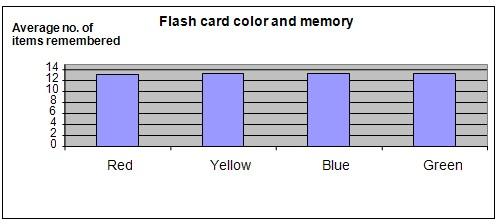| Complexity level: | 7 |
| Project cost ($): | 20 |
| Time required: | 1 hour to prepare, 2 hours for the science project experiment |
| Material availability: | Easily found |
| Safety concerns: | Basic safety requirements |
Hypothesis
Coloring flash cards will not help to improve memory retention and recall.
Overview
Memory
The memory is the ability of a person to remember or memorize information and being able to recall back the information when needed. Memories can be either short or long term. Short term memories are for things like the color of the shirt we wore to work two days ago or the name of the person we were introduced to last week. These are things that are not repetitive and have minimal importance to us. Long term memories include memories from our childhood, or our job skills. These things are of significant importance to us and are repetitive either currently or sometime ago in the past.
Psychologists have found that natural colored pictures or photos are able to enhance the ability of a person to remember the details of the photo. However, when their experiments were repeated using black and white photos, memory retention fell. Similarly when the experiments were performed using pictures that were colored with false, unnatural colors, the results did not differ much from the experiments conducted with black and white photos. Therefore we can conclude that it is the natural colors that help us to remember better, not the colors themselves.
Scientific Terms
Materials
The materials required for this science fair project:
- 10 participants
- 80 flash cards
- 4 crayons – red, yellow, blue and green
- 40 sheets of paper
- 10 pens
- a stopwatch
Procedure
1. For this science fair project, the independent variable is the color of the flash cards. The dependent variable is the ability of the participants to remember the contents of the flash cards. This is determined by asking them to write down what they saw. The constants (control variables) are the duration of time they are allowed to look at the flash cards and the number of flash cards used.
2. Four sets of flash cards are used in this science project. Each set contains of 20 cards. Each set of cards are colored using different colors - the first set is colored red, the secondset yellow, the third set blue and the fourth set green.
3. The 10 participants are made to sit in the same room. The first set of flash cards is shown to them one card at a time. The participants are allowed to look at each flash card for only 10 seconds before the next card is shown.
4. After all 20 flash cards are shown to the participants, the participants are each given a pen and a piece of paper. They are given 10 minutes to recall what they saw on the flash cards and to write it down on the sheet of paper. After the 10 minutes is over, tcollect their notes for analysis. The number of correct answers is counted and recorded.
5. The participants are given 30 minutes to rest. After that, procedures 3 and 4 are repeated using the second, third and fourth sets of flash cards.

Results
The results show that there was no significant difference in memory retention for any of the four sets of colored cards.
|
Flash card color |
Color of flash card and the number of correct memory recall |
Average |
|||||||||
|
1 |
2 |
3 |
4 |
5 |
6 |
7 |
8 |
9 |
10 |
||
|
Red |
12 |
13 |
13 |
14 |
13 |
12 |
15 |
13 |
14 |
13 |
13.2 |
|
Yellow |
14 |
14 |
11 |
15 |
12 |
12 |
14 |
12 |
16 |
14 |
13.4 |
|
Blue |
13 |
15 |
13 |
16 |
11 |
11 |
13 |
14 |
14 |
15 |
13.5 |
|
Green |
12 |
14 |
12 |
15 |
13 |
12 |
14 |
14 |
15 |
14 |
13.5 |
The chart below represents the results of our science project experiment.

Conclusion
The hypothesis that coloring the flash cards will not help to improve memory retention, is proven to be true.
There are many books and training programs about how to improve our memory. Among the common techniques used are to repeat the words or names many times, creating a joke or funny sentence about what to remember or creating a picture in your mind about the things to remember. Also, the things we see around us are all in color. This is why looking at a picture in the natural color helps us to remember it better.
Also consider
This science fair project may be repeated, this time, using colored words instead of pictures.
Modify the science project experiment, using naturally colored photos.
References
Memory - http://en.wikipedia.org/wiki/Memory
What is memory retention - http://ezinearticles.com/?What-is-Memory-Retention?&id=996416
Color psychology memory affects - http://www.yenra.com/color-psychology-memory-affect/

